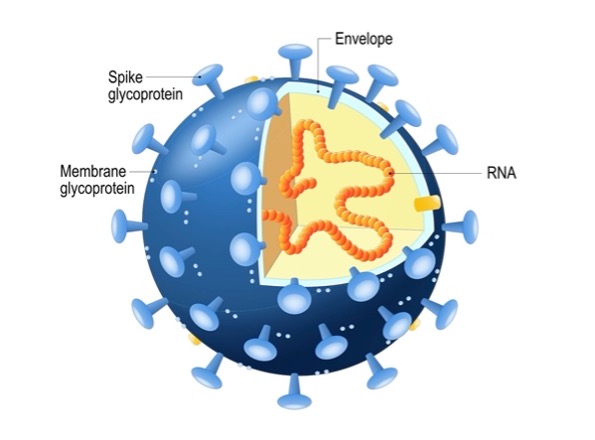Over the past 2.5 years, you’ve probably become familiar with what the COVID-19 virus (SARS-CoV-2) looks like.
Coronaviruses, in general, are named for the crown-like (corona) spikes coming off their surface (as shown in the picture of SARS-CoV-2 below).

SARS-CoV-2 Has a Pretty Simple Structure For Something That’s Caused So Much Destruction. The 3 Main Components of This VIrus Are:
1. It’s Genetic Material (which includes a single strand of tightly packed RNA-ribonucleic acid-at its core).
PediaTrivia: RNA is a cousin of DNA (another type of genetic material that you’ve probably heard of).
2. A Viral Envelope That Protects the RNA and Gives the Virus Its Structure.
3. Proteins Embedded in the Viral Envelope (Including the Spike Proteins Which Give SARS-CoV-2 Its Characteristic Appearance).

Why Are You Telling Me All of This?
Because once you understand the basic structure of SARS-CoV-2, it’s easier to understand how the virus attacks our cells. It also helps explain how the different COVID-19 vaccines target the virus.
How Does SARS-CoV-2 Attacks Our Cells?
Viruses are parasites that can only reproduce (and survive) by infecting a person’s (or an animal’s) cells.
In the case of COVID, SARS-CoV-2 uses its infamous spike proteins to latch onto our cells and enter them.
Note: The SARS-CoV-2 virus has a particular affinity for the cells in our respiratory tract (read: in our lungs).
When the virus enters our cells, it smartly uses our cells’ machinery to make new copies of itself and proliferate.
Super Brainy Scientists Used Their Knowledge of the Structure of SARS-CoV-2 to Create the Different COVID-19 Vaccines.
To Understand How the Various COVID-19 Vaccines Work, Let’s First Go Over Some Basic Vaccine Info:
- The purpose of vaccines is to trigger our immune system to make antibodies against the virus in question. If our immune system encounters the same virus later on, it will recognize it as “foreign” and send the already made antibodies out to attack it. This (ideally) prevents us from getting infected with the virus.
- Traditional vaccines trigger this immune response by injecting a small (and non-harmful amount) of the virus into our body. The virus may be inactive (read: “killed”), such as with the Hepatitis B vaccine, OR “live,” such as with the MMR (measles, mumps and rubella virus) vaccine.
Note: Don’t be scared off by the idea of “live” vaccines-only a tiny amount of a weakened form of the live virus is injected into our body.
Both the Pfizer and Moderna Vaccines, Which Are Approved for Children 6 Months & Up, are Types of mRNA Vaccines.
- mRNA vaccines work a bit differently than traditional vaccines. Instead of injecting a small amount of the virus into our body, they inject a small amount of mRNA into our body.
The mRNA, in this case, teaches our cells how to make the spike protein (or a piece of the spike protein) that’s found on the outer surface of the COVID virus. When our cells make the spike protein, our immune system recognizes it as “foreign” and starts making antibodies against it.
If a person gets infected with SARS-CoV-2 after he/she has been vaccinated against it, his/her immune system will release the preformed antibodies (made against the spike protein) and attack the virus. Pretty high tech, right?!
Insider Info:
- mRNA is naturally found in the cells of our body, but the mRNA in COVID-19 vaccines is created in a lab.
- Have No Fear: After the mRNA (in the vaccine) teaches our cells to make the spike protein (or a portion of it), our cells destroy the mRNA. This means the mRNA in the vaccine doesn’t enter the nucleus of our cells and alter our DNA (our genetic material).1 I only mention this because some people have been concerned that mRNA stays in the body and messes with our genetic material. According to vaccine experts, it doesn’t.
- Reality Check: Although mRNA vaccines sound fancy and New Age-y, researchers have been studying them and working with them for years (think: decades). For instance, mRNA vaccines have been studied in the past with rabies, the flu, and the Zika virus.2
Note: The Novavax and Johnson & Johnson COVID vaccines are NOT mRNA vaccines. Nor are they approved for young children. The Novavax vaccine can be given to people 12 & older, whereas the Johnson & Johnson vaccine is reserved for adults 18 & older.
The Bottom Line
Determining the structure of SARS-CoV-2 was a key step in understanding how the virus attacks our cells and how we can protect ourselves against COVID. Over time, the structure of SARS-CoV-2 has mutated, giving rise to variants such as Alpha, Beta, Delta, and Omicron. These variants have differences in the structure of their spike protein and in other components of the virus.
As the COVID-causing virus continues to evolve, vaccine makers will have to continue to modify their vaccines. This is why the new “bivalent” booster shot was created. The old (monovalent) booster shot protected us against the original strain of the COVID virus (SARS-CoV-2), but it wasn’t a great match for the Omicron variants. However, the new “bivalent” booster shot, protects us against BOTH SARS-CoV-2 and it’s Omicron subvariants BA.4 and BA.5, making it worth getting.





